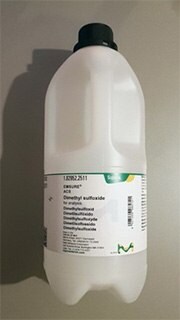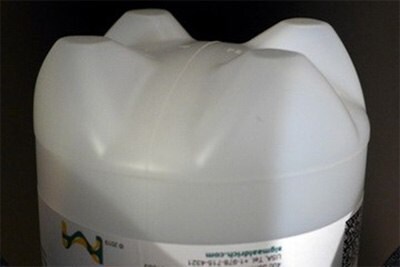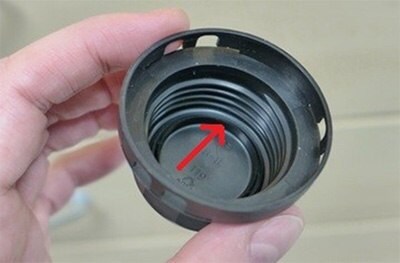Safe Chemical Containers
Even a bottle can be high-tech
Lab technicians often handle chemical-filled plastic bottles several times a day, but what many of them don’t know is that these seemingly unremarkable containers involve years of intricate development work.
Entering the large industrial building R22 in Darmstadt, Germany, you are immediately faced with walls of bottles in display cabinets: from amber glass ones from the 1950s in every imaginable shape and size to modern plastic ones which are used today in laboratories around the globe.
Here, a team of experienced developers and dedicated packaging engineers is responsible for quality control and the dispatch of newly developed packaging materials by Merck. They are always eager to find new solutions and improve existing packaging systems and are driven by this determination when considering questions of safety, handling, and economical solutions.
The entire department of around 50 employees dedicates itself to all things packaging. Bottles, stainless steel drums, cuvettes, cartons, and filling material – an estimated 300 different packaging materials are used to fill and transport Supelco® analytical products.
Long-term quality and exceptional purity
The importance of quality control cannot be understated. Supelco® chemical products used in analytical chemistry have to be especially pure, both during the filling process and in the laboratory several months later. Accuracy in the ppt range has to be ensured on the one hand, and the chemicals’ safe use on the other.
No ordinary bottle can meet such high requirements: even containers freely available on the market do not always satisfy the Supelco® standards of precision and quality. This is why the experts in Darmstadt develop their own bottles in close cooperation with both their colleagues in chemical production and with the help of feedback from customers all over the world.
From the idea, its design, and a 3D-printed prototype, to safety tests and then pre-series production – the development process can take several years. The choice of material is also crucial: whereas glass bottles used to be the standard, today high-quality plastic bottles made from a very special type of High-Density Polyethylene (HDPE) have become standard packaging for many chemicals.
The 2.5-liter bottle is developers’ pride and joy

The 2.5-liter HDPE bottle for Supelco® chemicals.
The latest 2.5-liter bottle, which is now used for Supelco® products worldwide, is also made from this special HDPE. It's the Darmstadt developers’ pride and joy – and it isn’t hard to see why.
In the globalized world of business, the first challenge in development is transportability. Regardless of whether customers are based in the United States, Asia, or Latin America, they can rest assured that their chemicals will boast the same purity and quality as when they left the Life Science company production site.
This requires special containers which can withstand greater loads without compromising the high-purity substances. “When we ship chemicals to Asia or South America, temperatures can easily reach 70 degrees Celsius in the containers during the week-long journey. Our bottles must of course be able to withstand this,” explained one of the packaging engineers. The problem here is not the temperature itself, but the large amount of pressure that is generated when liquids such as methanol, acetone, or hydrochloric acid heat up.
Glass bottles would easily withstand such pressure. However, the developers in Darmstadt know that they are not always first choice from a chemical safety point of view. For example, the content of iron, aluminum, or other cations in a sample from a glass bottle cannot be determined with reliable accuracy, because cations in particular separate from glass relatively easily.
The new bottle: pressure-stable, leak-proof and convenient for the user

Pressure-stable: HDPE-bottle with special base
The team had to develop an all-new 2.5-liter plastic bottle, ideally suited for the safe and precise use of quality chemicals in the laboratory.
Differences to other bottles on the market are immediately noticeable. First, there's the higher-pressure stability. “Conventional plastic bottles were almost dancing under the pressure in hot shipping containers,” described one engineer. The concave base was already bulging at a pressure of 0.5 bar, which of course meant that the bottles could no longer remain safely upright.
“We now have a bottle base that curves outwards by design, and four feet on the base ensure the bottle’s stability.” With this design, the bottle remains stable even up to a pressure of 2.5 bar.
Quality, safety, and precision in the lab
Yet stability isn’t everything. A cap that prevents any form of leakage is just as important in maintaining the chemical purity and ensuring safe and precise work in the lab. “If the cap is not leak-proof, parts of the chemical can escape or react with air. Both problems must be avoided by all means, especially for analytical and safety purposes,” the engineer pointed out, underlining the importance of the cap for the quality of Supelco® branded chemical products.
The special “S40” thread is therefore used for Supelco® bottles. It has more threads than the standard “GL45” and seals the contents more tightly. While the conventional screw cap only seals by applying contact pressure to one edge of the cap, the S40 thread has an additional groove in the bottle neck so that it seals in three places simultaneously.
Practical experience incorporated in product development

Additional sealing groove in the S40 screw cap
Practical lab use was a particular focus for the developers, which is evident in the small details of the all-new 2.5-liter bottle which increase safety and convenience. For example, they have a small, sharp lip that makes it easier to pour out the liquids. If a drop is left on the rim, it doesn't run down the outside of the bottle, but back into the bottle. The ideally sized, integrated handle also contributes to the bottle’s safety.
Many safety aspects are officially regulated by the chemical industry. For example, the writing on the labels must remain legible even if it comes into contact with acids or solvents. However, for the Darmstadt development and packaging team, industry standards only represent the minimum requirements.
Every single day they work on optimizing the packaging, always using valuable feedback from Supelco® customers. Customers for example reported that they found it difficult to open the bottles in the lab since they were sealed particularly tightly for safety reasons. The solution was as simple as it was pragmatic: a matching key fitting the screw cap’s special shape is available so that the bottles can be opened easily and safely.
Everything is being done to ensure that the chemicals reaching the customer are of the same quality as when they leave the Darmstadt plant.
To continue reading please sign in or create an account.
Don't Have An Account?